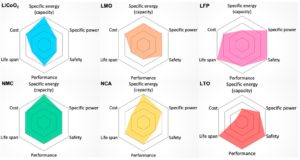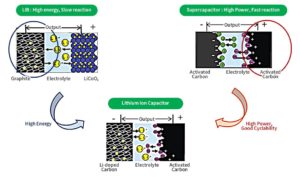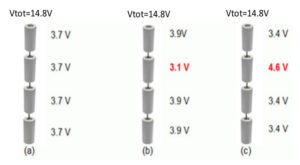A lithium-ion polymer (LiPo) battery (also known as Li-poly, lithium-poly, PLiON, and other names) is a rechargeable Li-ion battery with a polymer electrolyte in the liquid electrolyte used in conventional Li-ion batteries. There are a variety of LiPo chemistries available. All use a high conductivity gel polymer as the electrolyte. LiPos provide higher specific energies…
The difference between a lithium-ion battery and a lithium-ion capacitor
A lithium-ion capacitor (LIC) is a type of supercapacitor. It’s a hybrid between a Li-ion battery and an electric double-layer supercapacitor (ELDC). The cathode is activated carbon, the same as is found in an ELDC, while the anode consists of carbon material pre-doped with lithium ions, similar to those found in Li-ion batteries. LICs are…
Active cell balancing basics
Resistors, capacitors, inductors, and dc/dc converters can all be used in various topologies to provide cell balancing for battery packs. Cell balancing is needed to obtain the maximum performance since performance is limited by the weakest cell in the pack. Once the weakest cell is depleted, the pack stops delivering energy. The various cell balancing…
Running robots on ambient energy
The first FAQs in this series have identified specific use cases and applications where robots can use batteries, fuel cells, and even supercapacitors as their prime power source. Are there applications for robots that can benefit from using energy harvesting and ambient energy as their prime power source? Yes. For example, small nanorobots can use…
Where do supercapacitors fit in robots?
So far, this series of FAQs has looked at battery options for mobile robots, the most common powering option for robots, and the benefits of fuel cell power robot platforms were reviewed, including extended run times and faster recharge rates compared with battery power. Supercapacitors (also called ultracapacitors) bring another unique set of benefits to…
Fuel-cell-powered robot platforms
This series of FAQs is looking at various technologies being used to power robots. The first FAQ focused on “battery options for mobile robots.” Following this look at fuel cell-powered robot platforms will be FAQs considering “where do supercapacitors fit in robots?” and “running robots on ambient energy.” This FAQ will begin by looking at…
Battery options for mobile robots
Batteries are the most common power source for mobile robots. In today’s designs, lead-acid batteries have been mostly replaced by lithium chemistries. The two most common lithium chemistries in these applications are variations on lithium-ion (Li-ion), and lithium iron phosphate (LiFePO4). This FAQ will begin by comparing the performance capabilities of Li-ion and LiFePO4 batteries.…
Basics of battery charging circuit design
Charging batteries is simple (in theory) – put a voltage across the terminals and the battery charges. If safe charging, fast charging and/or maximum battery life are important, that’s when things get complicated. This article will consider various aspects of charging nickel-metal-hydride (NiMH), nickel cadmium (NiCd), lithium-ion (Li-ion), and lead acid (PbA) batteries. The three…
What’s the difference between battery isolators and battery separators?
Battery cell isolators and battery cell separators are used to control current flow in multi-battery systems in a range of vehicles, including recreational vehicles, boats, utility vehicles, airplanes, large trucks, and off-road vehicles that accommodate auxiliary loads and high current loads such as a recovery winch. Battery isolators are designed to prevent auxiliary batteries from…
Testing power consumption and batteries for wireless IoT nodes and wearables – Virtual Roundtable (part 2)
In this second part of EEWorld’s virtual round table on testing power consumption and batteries for wireless IoT nodes and wearables, our panelists delve into the nuances of complementary cumulative distribution function (CCDF) testing and predicting actual battery performance. Our panelists include: Janet Ooi (JO), IoT Industry Solutions Lead at Keysight Technologies, Shah Hassan (SH), […]










